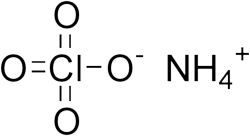Fate and effects of perchlorate
This article is the result of a collaborative effort between a student at Mount Holyoke College participating in the Encyclopedia of Earth's (EoE) Student Science Communication Project, and an expert on the topic. The project encourages students in undergraduate and graduate programs to write about timely scientific issues under close faculty guidance. This article has been reviewed by EoE editors.
Contents
- 1 Introduction Perchlorates are both man-made and naturally-occurring salts. Five types of this chemical are manufactured or mined in the United States (U.S.) and in other countries—ammonium perchlorate being the most common. Perchlorates exist in the environment as solids and they separate into two ions (Fate and effects of perchlorate) in water. The negatively charged anion is measured when water or other liquids are tested for perchlorates.
- 2 Perchlorate Exposure
- 3 Perchlorate Effects
- 4 Dosage
- 5 Reduction and Regulation
- 6 References
Introduction Perchlorates are both man-made and naturally-occurring salts. Five types of this chemical are manufactured or mined in the United States (U.S.) and in other countries—ammonium perchlorate being the most common. Perchlorates exist in the environment as solids and they separate into two ions (Fate and effects of perchlorate) in water. The negatively charged anion is measured when water or other liquids are tested for perchlorates.
 Figure 1. Structure of ammonium perchlorate. (Source: Wikimedia Commons, 2008)
Figure 1. Structure of ammonium perchlorate. (Source: Wikimedia Commons, 2008) Perchlorate modulates thyroid function as a competitive inhibitor of iodide uptake, and it has been used to treat certain thyroid disorders since the 1950s. Low concentrations of perchlorates have been detected routinely in the environment only since 1997. The perchlorate anion is a strong oxidizing agent, consisting of four oxygen atoms in tetrahedral arrangement around a central chlorine atom (Figure 1).
Because this is a chemical whose hazards are not fully understood, stakeholders—including the U.S. Department of Defense and other government agencies, industry producers and users, exposed communities, and environmental organizations—have become polarized over its regulation.
Pure perchlorate is a white, crystalline substance that becomes an explosive when mixed with organic, or carbon-based materials. Also, the pure form is explosively sensitive to shock. Perchlorate is reactive at normal environmental temperatures and at body temperature although at a much slower rate.
There are several important anthropogenic sources of perchlorates in the environment. The explosive properties of ammonium perchlorate make it a popular oxidizing agent in solid rocket fuel, air bag inflators, fireworks, and flares. As stated earlier, perchlorates are manufactured in the United States; and they are used extensively on U.S. military bases in a variety of devices. In addition, such naturally-occurring sources of perchlorate as potash fertilizer and evaporite soils exist. These are partly composed of highly soluble minerals that form readily through evaporation. Also, the chemical is present in the atmosphere.
Perchlorate Exposure
 Vegetables irrigated with perchlorate-laden water take up the toxicant, causing concern for contamination. (Source: Wikimedia Commons, 2008)
Vegetables irrigated with perchlorate-laden water take up the toxicant, causing concern for contamination. (Source: Wikimedia Commons, 2008) The primary mode of entry for perchlorate into the body is ingestion. It may also be inhaled if ions are present in the air in the form of perchlorate dust, which is most likely to occur in factories. Preliminary data indicate that perchlorate concentrations in U.S. public drinking water range from less than 4 to 260 ppb, or parts per billion. The California Department of Health Services monitored public drinking water sources and found that 375 out of 6,925 sources had perchlorate concentrations at or above 4 ppb, with the highest reported concentration at 820 ppb. The U.S. Environmental Protection Agency subsequently reported that over 11 million people have perchlorate in their drinking water at 4 ppb or greater. In addition to drinking water, much of the Colorado River and its surrounding streams and tributaries that irrigate a significant number of vegetables and fruits grown in the United States, are contaminated with perchlorate.
 Perchlorates have been detected in dairy milk. (Source: Wikimedia Commons, 2008)
Perchlorates have been detected in dairy milk. (Source: Wikimedia Commons, 2008) The detection of perchlorate in non-drinking water sources has, therefore, implications for human ingestion via the consumption of crops and livestock: perchlorate has been detected in dairy milk, as well as in a variety of other foods.
The U.S. Food and Drug Administration (FDA) recently completed an exploratory study that evaluated perchlorate concentrations in bottled water, dairy milk and lettuce. The mean concentration of perchlorate, sampled from 104 commercial milk supplies in 14 states, was 5.76 ug/L (micrograms per liter – or parts per billion (ppb)), three samples were below the detection limit and the maximum concentration was 11.3 ug/L. A 2008 FDA "Total Diet" study calculated the percentage of perchlorates ingested by people from all age groups (infants to adults) from 12 food groups (Table 1). Also, using this information, they determined the total daily intake of the toxicant for each age group per day (Table 2). Several published studies have documented the presence of perchlorate in human milk, raising concerns about neonatal exposure.
|
Table 1. Percentage of perchlorate intake in groups from 10 different types of food, modified from 2005 USDA Total Diet Study. Originally 12 types: Eggs and Fat/Oils, showing no perchlorate percentages for any age group, were omitted. Baby Food Beverage Dairy Fruit Grain Legume Mixture MPF Sweets Vegetable Infants 6-11 mo. 49 1 32 4 2 0 6 1 0 5 Children 2 yrs 0 3 51 15 6 0 8 4 1 12 Children 6 yrs 0 3 50 11 8 0 9 6 1 12 Children 10 yrs 0 4 47 9 8 0 10 5 1 16 Teenage girls 14-16 yrs 0 7 29 11 8 0 14 7 1 23 Teenage boys 0 7 37 7 9 0 12 7 1 20 Women 25-30 0 12 20 8 8 0 14 11 1 26 Men 25-30 0 12 20 5 8 0 16 9 0 30 Women 40-45 0 12 17 11 8 0 13 7 1 31 Men 40-45 0 11 21 8 9 0 13 8 1 29 Women 60-65 0 9 17 12 8 0 9 7 0 38 Men 60-65 0 9 19 9 8 0 10 8 0 37 Women 70+ 0 6 23 12 8 0 10 5 0 36 Men 70+ 0 7 22 12 9 0 10 7 0 33 While the focus of this article is on human health effects, there is also cause for concern about perchlorate ingestion by wildlife and livestock as well. Perchlorates have been shown to disrupt the endocrine systems (Fate and effects of perchlorate) of amphibians, fish, and mammals. Once again, the status of perchlorate as an emergent toxicant means its effects at current environmental levels are not fully understood, for animals and plants as well as humans. Perchlorate Effects Figure 2. Structure of triiodothyronine. (Source: Wikimedia Commons, 2008) Figure 2. Structure of triiodothyronine. (Source: Wikimedia Commons, 2008) The basic mechanism of perchlorate action on the thyroid has been understood since the 1950s. Perchlorate is a competitive inhibitor of iodide uptake by sodium iodide symporters (NIS), proteins that transport ions between cell membranes, in thyroid cells. Inhibition of iodide uptake results in decreased production of iodine-rich thyroid hormones triiodothyronine, or T3 (Figure 2) and thyroxine, or T4 (Figure 3). Thyroid hormone production is regulated by the hypothalamic-pituitary-thyroid axis. The thyroid produces T4 and T3, the pituitary gland produces thyroid stimulating hormone (TSH), and the hypothalamus maintains optimal T4 and T3 levels by responding to a negative feedback system. Cells in both the hypothalamus and pituitary gland respond to low levels of circulating T4 and T3; the hypothalamus stimulates the pituitary gland through thyrotrophic-releasing hormone (TRH) to produce TSH, that then prompts the thyroid to produce T4 and T3—starting the cycle over again. When thyroid production levels are low, the output of TRH and TSH increases. Circulating levels of T4, T3, and TSH in the body are used often as biomarkers of exposure and effect of agents (like perchlorate) that disrupt this system.  Figure 3. Structure of thyroxine. (Source: Wikimedia Commons, 2008) Figure 3. Structure of thyroxine. (Source: Wikimedia Commons, 2008) NIS expression has been demonstrated to occur in the mammary and salivary glands, placenta, stomach, and colon. Studies have shown that perchlorate inhibits iodine uptake not only in the thyroid, but also in non-thyroidal tissues such as the salivary glands, gastric mucosa, and lactating mammary gland. NIS expression in the placenta and mammary glands raises important questions regarding the potential for reduced iodide supply to the fetus and neonate, in conjunction with the delivery of NIS inhibitors via the placenta or milk. Although maternal thyroid hormone transfer is important throughout pregnancy, it is particularly important during the first half of pregnancy, before the fetus has developed its own functional thyroid, and during the first, critical stages of brain development. As the fetus develops the capacity to synthesize thyroid hormones, the demand for iodide increases greatly. A recent survey by the U.S. Centers for Disease Control and Prevention (CDC) indicates that up to one-third of women of childbearing age may have insufficient iodine intake. Furthermore, women with insufficient iodine intake appear to be more sensitive to the effects of perchlorate on thyroid hormone levels. Pregnant women with insufficient iodine intake may represent, therefore, the population of highest concern. The most significant hazard associated with perchlorate exposure is for developmental effects of the fetus or neonate resulting from thyroid hormone insufficiency, particularly during the early, critical developmental window. Although such extreme effects as cretinism (a condition of severely stunted physical and mental growth due to thyroid deficiency) are highly unlikely at current environmental perchlorate concentrations, other unknown neurological or developmental effects are possible. Although the mechanisms are still being studied, thyroid hormones are critical to neuronal migration and proliferation in the developing brain as well as to general development, reproductive function, and normal body metabolism. Similarly, while it is known that the effects inhibitors have on the thyroid can in turn lead to adverse effects on the digestive, cardiovascular and integumentary systems, it is not yet known what effect current concentrations of perchlorate have in the body. As with other toxicants, variables of dose, length of exposure, and the presence of other chemicals all contribute to its effects.
| ||||||||||||
